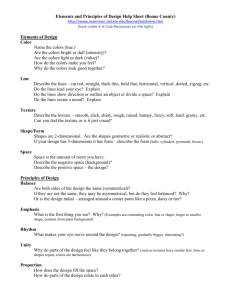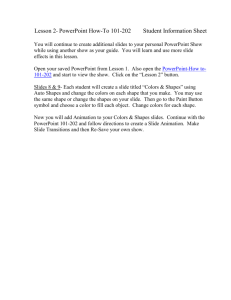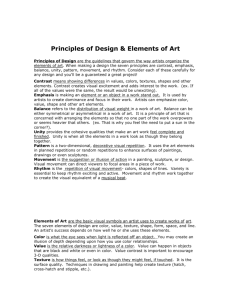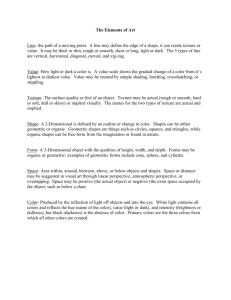formal elements handout
advertisement
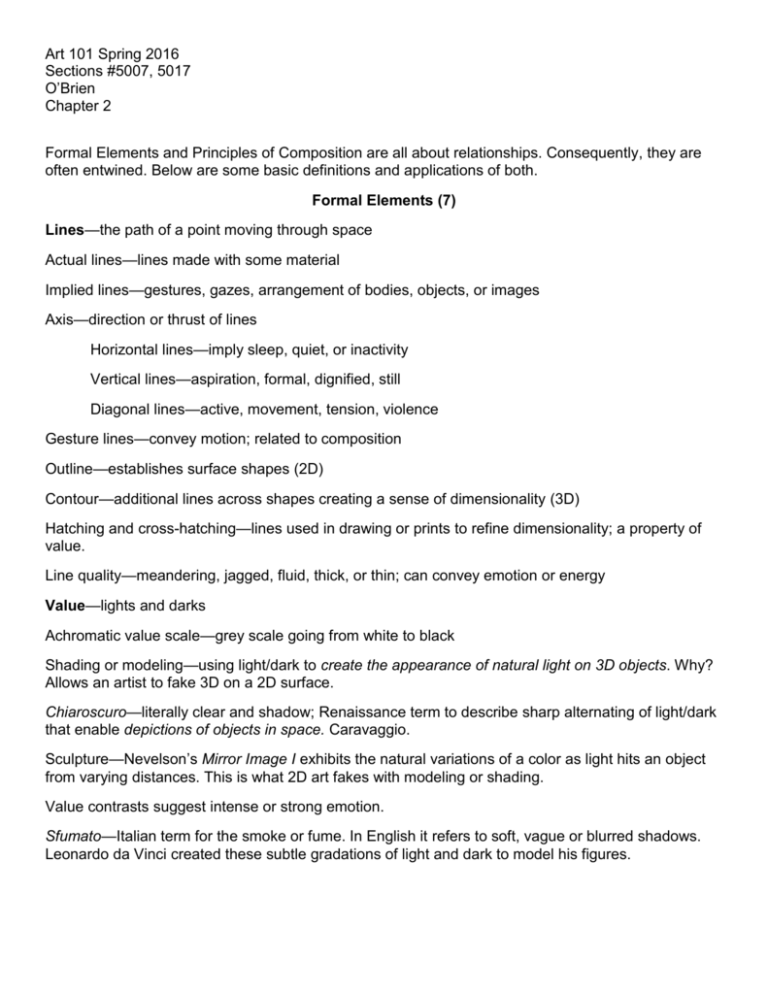
Art 101 Spring 2016 Sections #5007, 5017 O’Brien Chapter 2 Formal Elements and Principles of Composition are all about relationships. Consequently, they are often entwined. Below are some basic definitions and applications of both. Formal Elements (7) Lines—the path of a point moving through space Actual lines—lines made with some material Implied lines—gestures, gazes, arrangement of bodies, objects, or images Axis—direction or thrust of lines Horizontal lines—imply sleep, quiet, or inactivity Vertical lines—aspiration, formal, dignified, still Diagonal lines—active, movement, tension, violence Gesture lines—convey motion; related to composition Outline—establishes surface shapes (2D) Contour—additional lines across shapes creating a sense of dimensionality (3D) Hatching and cross-hatching—lines used in drawing or prints to refine dimensionality; a property of value. Line quality—meandering, jagged, fluid, thick, or thin; can convey emotion or energy Value—lights and darks Achromatic value scale—grey scale going from white to black Shading or modeling—using light/dark to create the appearance of natural light on 3D objects. Why? Allows an artist to fake 3D on a 2D surface. Chiaroscuro—literally clear and shadow; Renaissance term to describe sharp alternating of light/dark that enable depictions of objects in space. Caravaggio. Sculpture—Nevelson’s Mirror Image I exhibits the natural variations of a color as light hits an object from varying distances. This is what 2D art fakes with modeling or shading. Value contrasts suggest intense or strong emotion. Sfumato—Italian term for the smoke or fume. In English it refers to soft, vague or blurred shadows. Leonardo da Vinci created these subtle gradations of light and dark to model his figures. Color—has 3 basic characteristics 1. Saturation— AKA chroma or intensity; has to do with how much of a hue is present. A saturated color is a pure hue not diluted by its complement. A hue is dulled by the addition of its complement, producing a brownish greyish color. 2. Value—lightness and darkness 3. Temperature—Warm colors like red, orange, yellow feel closer and than blues, greens, and purples, which feel further away and cooler. Hue—is the color’s name Neutral colors—low intensity/saturation Color can have emotional or symbolic content. Complementary colors are opposites on the color wheel and create drama. Analogous colors are next to each other on the wheel and are less dramatic. Compare David’s women with the soldiers in Oath of the Horatii. Cezanne uses warm and cool colors to create depth and volume, but then intentionally sabotages this system and flattens space. Texture—can be actual or simulated. The illusion of texture can be created by manipulation of value. Shape and Volume/form Shape—is a closed line and expresses length and width, i.e., it is 2D Shapes can be geometric (circle, square, triangle, etc.) or organic (freeform or natural shapes) Positive shapes are defined by outlines or by areas of different value/color placed next to each other. Negative shapes are the spaces around shapes; they are equally significant in a composition. Volume/form is a 3D entity—like shape, volumes can be geometric or organic. We can talk about shapes in terms of composition (big shapes) and in terms of components of subject matter (smaller shapes). The same is true about form. Mass—physical bulk Space—is the area between and around shapes as well as the feeling of depth. An illusion in 2D. Planar space is 2D graphed with x and y axes; 3D uses x, y, and z axes. The illusion of space can be created by linear perspective. It is also created by overlapping, manipulation of scale, use of warm and cool colors, or value contrast. Linear Perspective—parallel lines appear to converge at a single point, two points or multiple points on the horizon Atmospheric perspective—things further away appear smaller and desaturated Foreground, middle ground, background—spatial markers created in painting or drawing Horizon line—point where land/sky meet; the line on which parallel lines seem to converge as they meet Space in 3D pertains to the literal space as well as to the solids and voids of the forms. Time and Motion Time—is relevant to film and kinetic art Motion—or movement of the subject matter is implied in most 2D artworks Duchamp’s Nude Descending a Staircase; is actual in kinetic art, film/video, and performance art. Principles of Composition (7-8) Motion also has to do with line direction, thrust and gesture within a composition. Balance in an artwork results from placing the components so that their visual weights seem evenly distributed. Symmetrical balance—refers to mirror images on each side of an imagined or actual vertical line dividing the composition. It can also refer to visual weight is distributed evenly: big shapes and bright colors “weigh” more than small shapes and light colors. Asymmetrical balance—activity balanced by calm; large elements balanced with smaller ones; areas of light balanced by areas of dark. Typically yields a more dynamic rhythm. Radial balance—all elements of a composition radiate outward from center, i.e., a mandala. Rhythm is the carefully repetition of elements separated by intervals—related to pattern; regular rhythm is repetition of some visual element; alternating rhythm is different elements placed side by side; eccentric is irregular but still adheres to pattern. Proportion and Scale Proportion refers to the relationship of part to whole. Polykleitos’ Spearbearer. Scale is the size of something in relation to what we consider normal; hieratic scale is a visual scale in which important figures are larger. Emphasis is the use of compositional devices to focus attention. Unity and Variety are related to pattern and rhythm. Unity—way of creating cohesion in an artwork. Variety—is the element of difference in an artwork. Alignments—are part of composition; the are relationships between things in terms of the way they line up.

